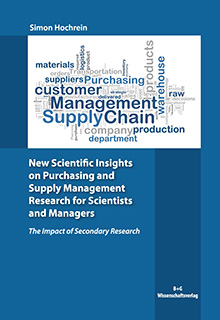Inhalt
Simon Hochrein
New Scientific Insights on Purchasing and Suppy Management
Research for Scientists and Managers
The Impact of Secondary Research
1 Introduction
1.1 Motivation and relevance of the research
1
1.2 Objectives and formulation of the research questions
3
1.3 Research design and positioning
7
References
12
2. Purchasing and Supply Management Research
Abstract
17
2.1 Introduction
18
2.2 Characteristics of literature reviews
19
2.2.1 Types and purposes of literature reviews
19
2.2.2 Taxonomy for the classification of literature reviews
20
2.3 Literature reviews in purchasing and supply management research
22
2.3.1 Process-oriented framework for systematic literature reviews
22
2.3.2 Evaluation criteria for systematic literature reviews
23
2.4 The current state of systematic literature reviews in purchasing and supply management research
24
2.4.1 Applying the process-oriented framework to purchasing and supply management research
24
2.4.2 Search and selection of systematic literature reviews in purchasing and supply management research
24
2.4.3 Data evaluation and analysis of selected systematic literature reviews in purchasing and supply management research
27
2.4.4 Critical analysis of the search strategy of selected systematic literature reviews in purchasing and supply management research
31
2.4.5 Lessons learned and implications for future research
35
2.5 Limitations of the literature review
36
2.6 Conclusions
37
References
38
3. Supply Chain Management Research
Abstract
42
3.1 Introduction
43
3.2 Characteristics of literature reviews
44
3.2.1 Secondary literature reviews and review taxonomy
44
3.2.2 Tertiary literature reviews and evaluation criteria
45
3.2.3 Dimensions of analysis and content categories of this literature review
49
3.3 The literature review approach of this study
52
3.4 The current state of literature reviews in supply chain management research
55
3.4.1 Taxonomic classification of selected systematic literature reviews in supply chain management research
55
3.4.2 Critical analysis of the search strategy of selected systematic literature reviews in supply chain management research
56
3.4.3 Content classification of selected literature reviews in supply chain management research
58
3.5 Research agenda for future literature reviews in supply chain management research
59
3.5.1 Taxonomic and methodological lessons learned
59
3.5.2 Thematic implications for future research on supply chain management
62
3.6 Limitations of the literature review
64
3.7 Conclusions
64
References
66
4 Research on the Organization of Purchasing
Abstract
76
4.1 Introduction
77
4.2 The literature review approach of this study
78
4.2.1 Methodological background
78
4.2.2 Conceptual framework
80
4.2.3 Descriptive analysis
83
4.3 Thematic analysis on the organization of purchasing
85
4.3.1 Structural characteristics of the purchasing organization
85
4.3.2 Determinants of the purchasing organization
91
4.3.2.1 Organizational characteristics
91
4.3.2.2 Product characteristics
94
4.3.2.3 Purchase situation
95
4.3.2.4 Company-external (environmental) factors
98
4.3.3 Purchasing organization as a contextual variable
99
4.3.4 Structural types of the purchasing organization in private institutions
100
4.3.4.1 Sourcing teams
100
4.3.4.2 Commodity management
101
4.3.4.3 International procurement offices
102
4.3.4.4 Cooperative sourcing
102
4.3.4.5 Typologies of organizational models
103
4.3.5 Structural types of the purchasing organization in public institutions
104
4.3.5.1 Sourcing teams
105
4.3.5.2 Commodity management
105
4.3.5.3 Intergovernmental cooperative sourcing
105
4.3.5.4 Typologies of organizational models
106
4.3.6 Performance impact of the purchasing organization
107
4.4 Research agenda and directions for future research on the organization of purchasing
109
4.4.1 Structural characteristics and determinants of the purchasing organization
109
4.4.2 Structural types of the purchasing organization in private institutions
110
4.4.3 Structural types of the purchasing organization in public institutions
110
4.4.4 Performance impact of the purchasing organization
111
4.4.5 Theoretical research on the organization of purchasing
112
4.5 Limitation of the literature review
114
4.5.1 Limitations of the conceptual framework
114
4.5.2 Limitations of the research methodology
115
4.6 Conclusions
115
References
116
5. Research on the Performance Impact of Purchasing and Supply Management Practices
Abstract
125
5.1 Introduction
126
5.2 The literature review approach of this study
127
5.2.1 Conceptual framework
127
5.2.2 Methodological background
131
5.2.3 Descriptive analysis
135
5.3 Thematic analysis on the performance impact of purchasing and supply
138
5.3.1 Alignment of goals and strategies and strategic purchasing
138
5.3.2 Organization and process design
146
5.3.3 Human resources
147
5.3.4 Methods and tools
150
5.3.5 Supplier and supply base management
150
5.3.5.1 Supplier evaluation and selection
151
5.3.5.2 Supplier development
154
5.3.5.3 Supplier partnering and integration
157
5.3.5.4 Supplier involvement in new product development and design
163
5.3.5.5 Combined supplier-related practices
168
5.3.6 Information systems and technologies
171
5.3.7 Supply market-related decisions
177
5.3.8 Sustainable management
180
5.3.8.1 Environmental purchasing and supply management practices
181
5.3.8.2 Social purchasing and supply management practices
184
5.3.8.3 Sustainable purchasing and supply management practices
185
5.3.9 Quality management and just-in-time
185
5.3.9.1 Quality-related purchasing and supply management practices
186
5.3.9.2 Just-in-time purchasing and supply management practices
188
5.3.10 Multi purchasing and supply management practices
190
Design analysis on the constructs and measures of a buying firm's performance outcomes
191
5.4.1 Conceptualization of a buying firm's performance outcomes
191
5.4.1.1 Business performance
192
5.4.1.2 Purchasing and supply performance
193
5.4.1.3 Manufacturing performance
194
5.4.1.4 Project performance
195
5.4.1.5 Environmental and social performance
195
5.4.2 Measurement of a buying firm's performance outcomes
197
5.5 Methodological analysis on the characteristics and variables of the research design and research agenda for future empirical surveys
200
5.6 Limitations of the literature review
210
5.6.1 Limitations of the conceptual framework
210
5.6.2 Limitations of the research methodology
211
5.7 Conclusions
211
References
213
6 Conclusive Summary of the Key Research Findings
6.1 Contributions of the research
235
6.2 Limitations of the research
240
References
243
Appendices
244

